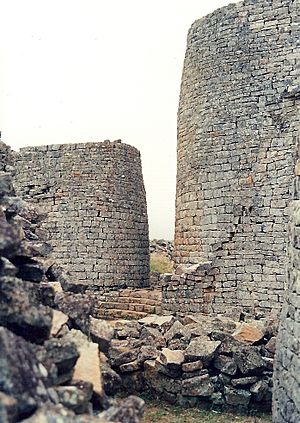Kingdom of Zimbabwe facts for kids
Quick facts for kids
Kingdom of Zimbabwe
Zimbabwe
|
|||||||||||
|---|---|---|---|---|---|---|---|---|---|---|---|
| c. 1220–1450 | |||||||||||
| Capital | Great Zimbabwe | ||||||||||
| Religion | Belief in Mwari | ||||||||||
| Government | Monarchy | ||||||||||
| Mambo | |||||||||||
|
• c. 1220-?
|
Rusvingo (first) | ||||||||||
| History | |||||||||||
|
• Abandonment of Mapungubwe for Zimbabwe
|
c. 1220 | ||||||||||
|
• Zimbabwe conquest of Mutapa
|
1430 | ||||||||||
|
• Abandonment of Zimbabwe for Mutapa
|
1450 | ||||||||||
| ISO 3166 code | ZW | ||||||||||
|
|||||||||||
The Kingdom of Zimbabwe was an important African kingdom that existed a long time ago, from about 1220 to 1450. It was located in the country we now call Zimbabwe. The capital city of this kingdom was Great Zimbabwe, which means 'Great House of Stone'. It was the biggest stone building in southern Africa before European settlers arrived. This powerful kingdom started after another kingdom, called Kingdom of Mapungubwe, ended.
Contents
What's in a Name?
The name "Zimbabwe" comes from the Shona language. It means "great house of stone." The capital city, Great Zimbabwe, was known for its amazing stone structures. These ruins are in the southeastern part of the country today. They are now a protected historical site.
The word "Zimbabwe" comes from Zimba-ra-mabwe or Zimba-re-mabwe. In the Karanga dialect of Shona, this means "houses of stones." Zimba means "great house," and mabwe means "stones." These stone buildings were very important. They were used by royalty and had spiritual meaning.
A Look at History
How Mutapa Rose to Power
For a long time, the Kingdom of Zimbabwe was very strong. But around the 15th century, a new state began to grow. This was the Mutapa state. It controlled a large area between several rivers.
Around 1430, a prince named Nyatsimba Mutota left Great Zimbabwe. He traveled north to find salt. With his army, he defeated local groups. He then started his own kingdom, called the Kingdom of Mutapa. This new kingdom quickly became more powerful than Great Zimbabwe. By 1450, the capital city of Great Zimbabwe was mostly empty. The kingdom had been abandoned.
What Happened Next?
When the Kingdom of Zimbabwe ended, its power split into two main areas. In the north, the Kingdom of Mutapa continued many of Zimbabwe's ways of governing. However, they did not build as many large stone structures.
In the south, the Kingdom of Butua was formed. It was like a smaller version of Zimbabwe. Eventually, both of these states became part of an even bigger and stronger kingdom. This was the Rozwi Empire.
How the Kingdom Was Run
The Kingdom of Zimbabwe was led by a ruler called a Mambo. The society had a clear class system with three levels. The kingdom collected taxes from other rulers in the region.
The kingdom included over 150 smaller areas. Each of these areas had its own smaller stone settlement, or "zimbabwe." The Kingdom of Zimbabwe ruled over a larger area than earlier kingdoms like Mapungubwe. It also ruled over later ones like Butua and Mutapa.
Economy and Culture
The Kingdom of Zimbabwe was very important for trade. It controlled the trade of ivory and gold from inland Africa to the coast. Goods from Asia and Arab countries were common in the kingdom.
The people of Great Zimbabwe also raised animals. Cattle were especially important for the wealthy people. Their riches often came from managing these herds. The kingdom's people also mined valuable minerals. They found gold, copper, and iron.
The rulers, or Mambo, brought their artistic skills from Mapungubwe. They were especially good at stonemasonry. The building of detailed stone structures and walls reached its peak in this kingdom.
See also
- Kingdom of Butua
- Kingdom of Mutapa
- Khami
- Danan'ombe



